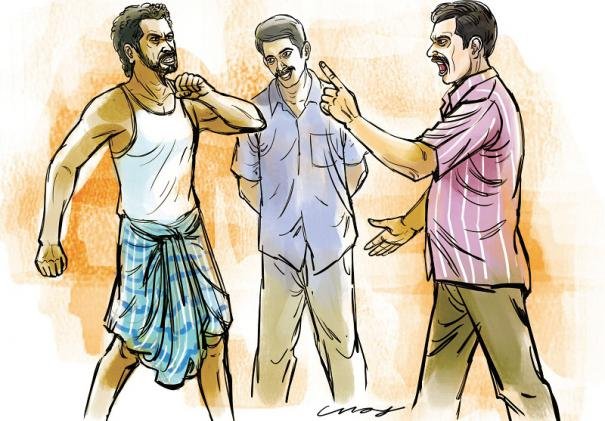Nepal: Disaster in Nepal -amplified by capitalism
Nepal, one of the poorest countries in the south Asian region has been further devastated by the recent earthquake.
Nepal, one of the poorest countries in the south Asian region has been further devastated by the recent earthquake. More than 5,000 people are estimated to have perished and around 10,000 estimated to be injured. But the number of deaths and injured people are expected to become much higher as time passes. This large-scale earthquake hit almost the entirety of Nepal, affecting 39 districts and impacting on the everyday lives of over two million people. There are reports that some villages were completely flattened.
Most of the victims were rural poor and the poor in the cities who lived in “precarious housing”. According to the UK Guardian, “almost exclusively older, brick and wood homes were reduced to rubble”. Poor families had lost lives and all they had. The Guardian reports the grief of a paralysed newspaper seller who is angry and desperate: “If we had money we would have built a strong house. But we had none. There is no place to go. There is no one to look after us. Life was hard for us already. I don’t want to be alive”. Added to their woes is that, for the injured, there is severe shortage of medical facilities and the threat of diseases spreading. There is not enough emergency shelter or food for all those affected.
But the government of Nepal and geologists across the world knew in advance that a disaster of this scale was waiting to happen, given the understanding about the movement of seismic plates in the sub-continent. And yet the Nepal government and other governments in the region made no effort whatsoever to prepare and take precautions to prevent death and disaster in the event of a major earthquake. The scale of the disaster is therefore manmade in a sense that it could have been lessened dramatically if adequate preventive measures were put in place.
A disaster of this scale also exposes the inability of the capitalist governments across the world. Exposed is their inability to plan production so that the needs of the masses can be met, lifting them out of poverty and from the dire living conditions. Lack of investment in adequate infrastructure and preventive measures further adds to the misery that is caused by such a natural disaster. Even the reports published by the Nepal government pointed in 2013 to the poor building practices and inadequacy of infrastructure – and warned that it would amplify the disaster in the event of earthquake. The Nepal government appears to have disregarded these warnings. Instead an endless tug of war was waged between the Unified Communist Party of Nepal–Maoist (UCPN-M) and the right-wing Nepali Congress (NC) and their ally the Communist Party of Nepal–United Marxist-Leninist (CPN-UML), regarding establishing a new constitution.
The Maoists (UCPN-M) gained significant support in 2006 after the great general strike saw the end of the rule of the Nepal king. This was regarded then as a significant ‘political earthquake’ which was to shape the whole region. Nepali workers, peasants and poor turned up in tens of thousands demanding not just the overthrow of the kingdom, but the establishment of a new government which reflected their interests. This desire was echoed in India, and many other countries in the region where many people hope to revive the movements against their rotten capitalist governments.
However, the Maoists who initially represented this desire for reforms, failed to carry through the socialist revolution which would have enabled them to carry out the wishes of the masses. Nepal is a small country with limited resources and sandwiched between two regional powers which compete to exploit the country. Breaking with capitalism and implementing a socialist planned economy with the aim of spreading it across the region and beyond will be the only way out for the Nepalese masses and to free them out of their shackles. A socialist federation of south Asia, bringing together resources from that region under the democratic control of the working people, would pave the way to plan the enormous resources concentrated in the region. It would mean bettering the life for all and implementing measures which would enable them to deal with natural disasters.
Despite the favourable conditions that existed, the Maoists have argued that they need to pass through a ‘bourgeois democratic stage’ of the revolution. They have argued the need for an alliance with the right-wing NC, and UML, at the time when support for these parties was in decline due to their past collaboration with the monarchy. These pro-capitalist parties put this to good use by continually extending the negotiations for a new constitution – buying time to strengthen their grip on power. They were able to regain strength and influence. The direct involvement of the Indian and Chinese governments also helped to strengthen these right-wing parties. They continue to argue that they are the only choice for the Nepalese masses. This was reinforced by the Maoists who continued to argue that they needed to collaborate with them to go forward. Prolongation of the discussions meant that the people not only did not get any ‘constitution’ but also won only very few improvements in their life. Capitalists and the media, which work as their mouthpiece, levelled all the blame on the Maoist. They were blamed for blocking the way forward. The right wing parties gained more muscle out of this and continued their propaganda. This was evident at the 2013 election when the UCPN-Maoists suffered a significant loss of support.
Now the ruling pro-capitalist parties wanted to implement their constitution without getting any agreement from the Maoists. This forced the Maoists recently to call for a three-day bandth (general strike). However the Maoists were exposed in the eyes of the masses as they had shown themselves unable to meet the demands of the workers, peasants, other minorities and the poor. The Maoists suffered a split and their popularity is diminishing.
However, the short period of support enjoyed by the ruling right-wing parties has been put into question by the recent earthquake. There is a massive discontent emerging against the government due to its mishandling of the disaster. This could lead to the emergence of a new movement against the government. Natural disasters sometimes can spark a revolution as they expose the incapacities of capitalism to protect the lives of ordinary people. The 1972 earthquake in Nicaragua, for example, devastated the lives of many who were suffering under the rule of the Somosa dictatorship. The mass homelessness, unemployment and devastation that followed strengthened the Sandinista movement, eventually leading to the overthrow of the regime.
More than a quarter of the 28 million strong population lives below the poverty line in Nepal. The rural poor in particular suffer from a dire lack of clean water and other basic facilities. Now huge economic burden of overwhelming disaster is also transferred on to their heads. All the parties have claimed to be in opposition to the kingdom of the past, yet no meaningful land reforms have been carried through. The King is still one of the largest land-owners in the world.
The damage to the economy due to the disaster is already expected to exceed $5 billion, more than 20% of the GDP. The poor who constitute the overwhelming majority of the population will be expected to make further sacrifices. Capitalist governments across the world pretend to be ‘sympathetic’ but have offered very little help so far. A mere £5 million from UK government made available to the charities is nowhere near the amount needed. The US initial promise of a stinky $1 million help was even less than some of the poor countries are pledging. This aid is nowhere near the resources needed to provide essential services. According to UNICEF, apart from anything else, 940,000 Nepalese children are in urgent need of humanitarian assistance.
As we saw in the 2004 tsunami disaster in South Asia, people across the world reacted faster and donated more than governments. There is no reliable mechanism to translate the generosity of people across the world into real effective relief efforts. As we saw after the Gujarat earthquake in India or the flooding in Pakistan and Bangladesh, and the tsunami disaster, so-called promises from governments are never fully delivered. And significant portions of the money that people donate to charities doesn’t get to the people in need but is wasted through ‘administrative’ functions and at times also channelled to government departments to meet their own propaganda needs. Famously the former dictatorial president Mahinda Rajapaksa in Sri Lanka distributed the tsunami relief water during rallies of his election campaign. Already reports are emerging of how the Indian and Chinese governments are using the ‘opportunity of disaster’ to strengthen their own influence in the country.
This disaster exposes the inability of Nepal’s government and the hypocrisy of the capitalist governments of the world. The need for alternative ways of governing will be raised in the eyes of the masses. The implementation of social production – a socialist planned economy could not only lift the masses out of poverty but also will plan and implement adequate measures to minimise the disaster that nature causes.
The poor masses cannot trust the government to deliver an effective aid program. Already evidence is emerging about the mismanagement of relief efforts. Democratically elected committees of workers, peasants and poor should be set up to control aid and an emergency rebuilding programme. These committees should have the power to provide compensation to the families of those who lost lives and property, control the prices of property and land and the prices of other essentials, including building materials. Capitalist vultures, trying to make gains from the disaster, should be kept away by the bringing into democratic public ownership and control all corporations and organisations that are involved in an emergency rebuilding programme.




















